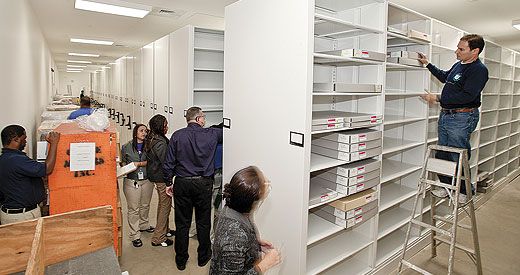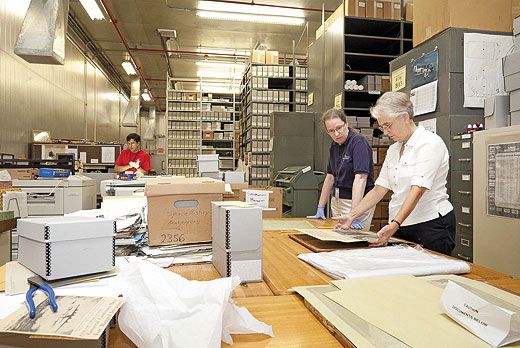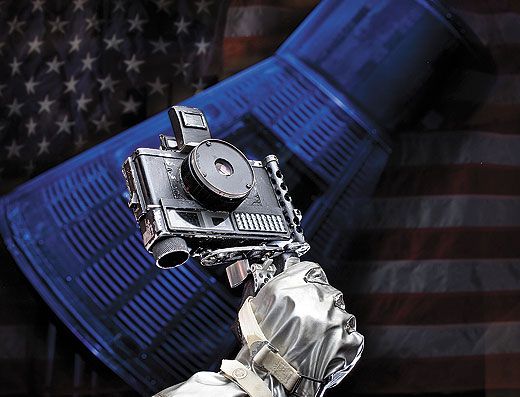The Archives’ Big Move
Fifty-four truckloads of irreplaceable aviation history make the 35-mile trek to the National Air and Space Museum’s Udvar-Hazy Center.
/https://tf-cmsv2-smithsonianmag-media.s3.amazonaws.com/filer/in-the-museum-aug-2012-2_FLASH.jpg)
On a crisp autumn morning last October, the first moving vans rolled away from Building 12 at the Paul E. Garber Preservation, Restoration and Storage Facility, in Suitland, Maryland. The trucks—carrying office furniture, computer equipment, and collection materials—were headed for the archives division’s new home, at the Steven F. Udvar-Hazy Center in northern Virginia.
Over five weeks, 54 truckloads of irreplaceable materials would make the 35-mile trek. To prepare, the archivists packed the entire collection of manuscripts—personal papers, diaries, technical manuals, corporate records, scrapbooks, and pilots’ logbooks—into 17,000 containers. Some 13,000 reels of motion picture film—everything from a 1910 newsreel of former President Theodore Roosevelt hitching a ride on a Wright Type AB to astronauts’ home movies—made the trip in a special climate-controlled truck. Wearing coats, hats, and mittens, the archivists worked in a vault kept at 38 degrees Fahrenheit to prevent film from deteriorating. They transferred film canisters from shelves to net bags normally used for shipping poultry. (Think of Thanksgiving turkeys chilling in your grocery store’s freezer aisle.) “That was a technique we learned from the National Archives when they moved their film collection,” says Marilyn Graskowiak, chair of the archives division.
Over 11 months, the staff rehoused more than 6,500 glass-plate negatives—including images of the restoration and flight-testing of the Langley Aerodrome in 1914—in boxes designed to withstand the bumpy ride.
Approximately 1,000 tubes of rolled aircraft engineering drawings made the move, and now wait to be unfurled and placed in a new, sevenfoot map case.
The collections were gathered from two buildings at the Garber facility and from five areas within the Museum on the National Mall. Archivists inventoried the collection, noting any conservation problems that needed to be addressed before the move.
Once the move began, each box, tube, and drawer was labeled with a color-coded sticker, confirmed on an inventory list, and shrink-wrapped for the journey. When each truck was filled, Graskowiak signed a manifest, and watched as the truck was sealed.
An archivist drove behind each truck as it made its way to the Udvar- Hazy Center. For the Ramsey Room items—rare books, manuscripts, and the like, normally kept in a locked, climate-controlled area—archivist Patti Williams rode in the moving van itself. “The Ramsey Room held our most intrinsically valuable material,” she explains, “including autographed photographs, philately, historic aviation letters, and first air meet material.” (One example: A National Aeronautic Association letter signed by witnesses attesting to the Wright brothers’ 1903 flight.)
When the trucks arrived at the Udvar-Hazy Center, the process was reversed: An archivist watched as the truck’s seal was broken, signed off on the manifest, and made sure the collection materials were placed correctly in their new locations, according to the inventory list.
The archives’ new setting boasts more shelving space for general collections. “We were coming to the point where we had only three to five percent more space left [for incoming collections],” explains Graskowiak. “We would have had to turn down collections.” The Udvar-Hazy location also has a larger reading room, which can accommodate 16 researchers. (The Garber facility could assist only three researchers at a time.) “For the first time,” says Graskowiak, “researchers will be able to access the vast majority of the Museum’s document and photo collections in one location.”
On a more mundane level, the new facility has a kitchen—and a bathroom. (At Garber, archivists and researchers had to make a mad dash through rain, sleet, or snow to use the restroom in the security officers’ quarters.)
Even during the extensive preparations and the move itself, the archives remained open. During the months of packing, archivists in the reading room of the Museum on the Mall assisted more than 180 visiting researchers.
Visit airandspace.si.edu/research/arch/ to learn more about the archives, including hours of operation, the scope of its collection, and how to volunteer.


